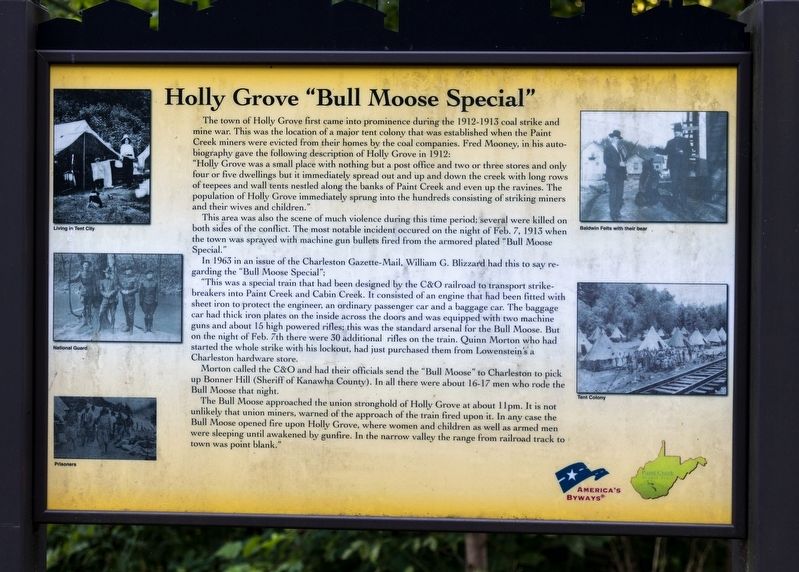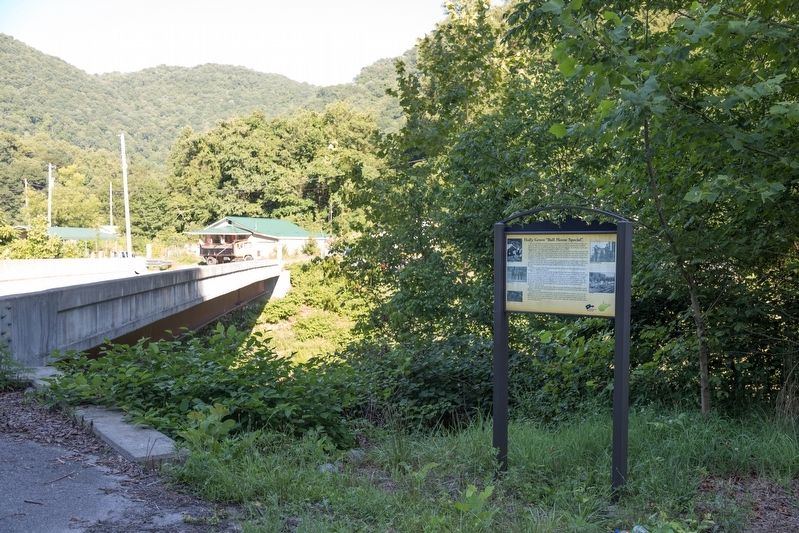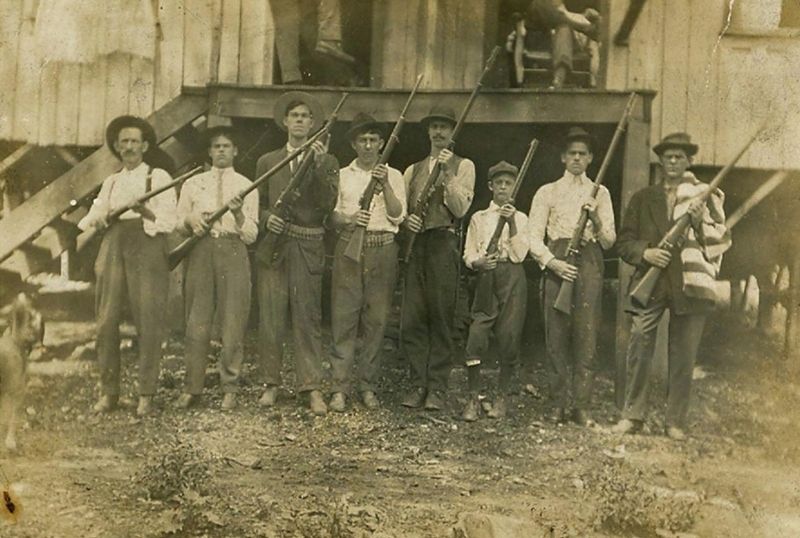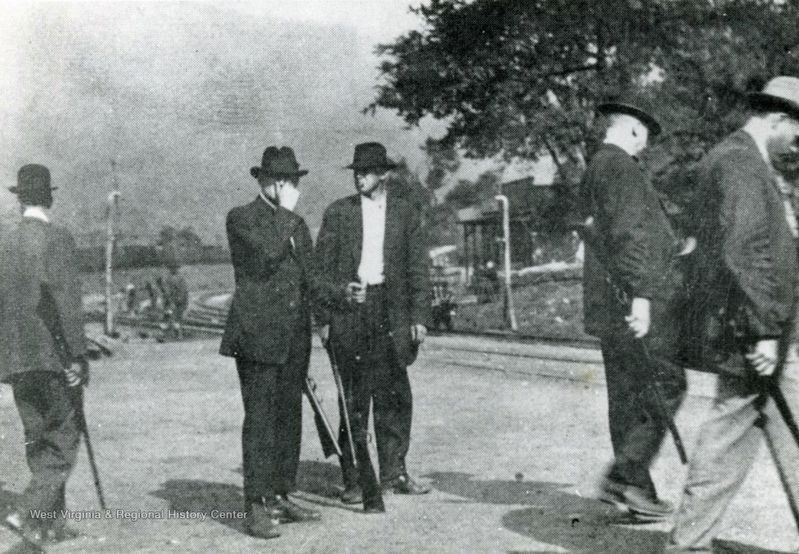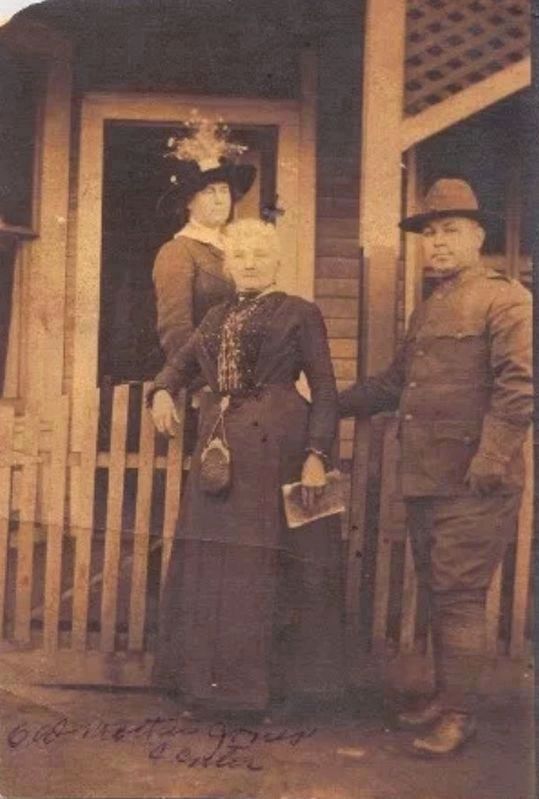Near Hansford in Kanawha County, West Virginia — The American South (Appalachia)
Holly Grove “Bull Moose Special”
— Paint Creek Scenic Trail —
Holly Grove was a small place with nothing but a post office and two or three stores and only four or five dwellings but it immediately spread out and up and down the creek with long rows of tepees and wall tents nestled along the banks of Paint Creek and even up the ravines. The population of Holly Grove immediately sprung into the hundreds consisting of striking miners and their wives and children.
This area was also the scene of much violence during this time period; several were killed on both sides of the conflict. The most notable incident occurred on the night of Feb. 7, 1913 when the town was sprayed with machine gun bullets fired from the armored plated “Bull Moose Special.”
In 1963 in an issue of the Charleston Gazette-Mail, William G. Blizzard had this to say regarding the “Bull Moose Special”
This was a special train that had been designed by the C&O railroad to transport strikebreakers into Paint Creek and Cabin Creek. It consisted of an engine that had been fitted with sheet iron to protect the engineer, an ordinary passenger car and a baggage car. The baggage car had thick iron plates on the inside across the doors and was equipped with two machine guns and about 15 high powered rifles; this was the standard arsenal for the Bull Moose. But on the night of Feb. 7th there were 30 additional rifles on the train. Quinn Morton who had started the whole strike with his lockout, had just purchased them from Lowenstein’s, a Charleston hardware store.
Morton called the C&O and had their officials send the “Bull Moose” to Charleston to pick up Bonner Hill (Sheriff of Kanawha County). In all there were about 16-17 men who rode the Bull Moose that night.
The Bull Moose approached the union stronghold of Holly Grove at about 11 pm. It is not unlikely that union miners, warned of the approach of the train fired upon it. In any case the Bull Moose opened fire upon Holly Grove, where women and children as well as armed men were sleeping until awakened by gunfire. In the narrow valley the range from railroad track to town was point blank.
Erected by America’s Byways - Paint Creek Scenic Trail.
Topics. This historical marker is listed in these topic lists: Industry & Commerce
• Labor Unions • Law Enforcement • Natural Resources. A significant historical date for this entry is February 7, 1913.
Location. 38° 11.43′ N, 81° 23.736′ W. Marker is near Hansford, West Virginia, in Kanawha County. Marker is at the intersection of Paint Creek Road (Local Route 83) and Holly Grove Drive, on the right when traveling north on Paint Creek Road. Touch for map. Marker is in this post office area: Hansford WV 25103, United States of America. Touch for directions.
Other nearby markers. At least 8 other markers are within 3 miles of this marker, measured as the crow flies. Bull Moose Special (a few steps from this marker); Mucklow / Gallagher, WV (approx. 2.3 miles away); In Honor and Memory of William Morris (approx. 2½ miles away); Cedar Grove Veterans Memorial (approx. 2½ miles away); Historic Church (approx. 2½ miles away); Major William Morris Jr. (approx. 2½ miles away); Virginia's Chapel (approx. 2½ miles away); First Settlers (approx. 2½ miles away).
Also see . . .
1. Wikipedia Entry for Paint Creek–Cabin Creek strike of 1912. Excerpt:
The strike lasted from April 18, 1912 through July 1913. After the confrontation, Fred Stanton, a banker, estimated that the strike and(Submitted on August 13, 2019.)ensuing violence cost $100 million. The confrontation directly caused perhaps fifty violent deaths, as well as many more deaths indirectly caused by starvation and malnutrition among the striking miners. In the number of casualties it counts among the worst conflicts in American labor union history.
The strike was a prelude to subsequent labor-related West Virginia conflicts in the following years, the Battle of Matewan and the Battle of Blair Mountain.
...
Mother Jones was arrested on February 13 in Pratt and charged in military court for inciting riot (reportedly for attempting to read the Declaration of Independence), and, later, conspiracy to commit murder. She refused to recognize the jurisdiction of the military court, and refused to enter a plea. Jones was sentenced to twenty years in the state penitentiary and acquired a case of pneumonia. New governor Dr. Henry D. Hatfield was sworn in on March 4 and immediately traveled to the area as his first priority. He released some thirty individuals held under martial law, transferred Mother Jones to Charleston for medical treatment, and in April moved to impose conditions for the strike settlement. Strikers had the choice to accept Hatfield’s somewhat favorable terms, or be deported from the state. The Paint Creek miners accepted and signed the “Hatfield Contract” on May 1. The Cabin Creek miners continued to resist, with some violence, until the end of July.
Mother Jones remained under house arrest, in Mrs. Carney's Boarding House, until she smuggled out a message through a secret trapdoor in her room, a message sent to pro-labor Indiana Senator John Worth Kern. Governor Hatfield released Jones, without comment, after a total of 85 days imprisonment.
The Senate’s Kern Resolution of May 26, 1913 led to the United States Senate's Committee on Education and Labor opening an investigation into conditions in West Virginia coal mines.
2. Wikipedia entry for Mary Harris Jones. Excerpt:
Jones worked as a teacher and dressmaker, but after her husband and four children all died of yellow fever in 1867 and her dress shop was destroyed in the Great Chicago Fire of 1871, she became an organizer for the Knights of Labor and the United Mine Workers union. From 1897 onwards, she was known as Mother Jones. In 1902, she was called “the most dangerous woman in America” for her success in organizing mine workers and their families against the mine owners. In 1903, to protest the lax enforcement of the child labor laws in the Pennsylvania mines and silk mills, she organized a children's march from Philadelphia to the home of President Theodore Roosevelt in New York.(Submitted on August 13, 2019.)
...
During the PaintCreek–Cabin Creek strike of 1912 in West Virginia, Mary Jones arrived in June 1912, speaking and organizing despite a shooting war between United Mine Workers members and the private army of the mine owners. Martial law in the area was declared and rescinded twice before Jones was arrested on 13 February 1913 and brought before a military court.
...
After 85 days of confinement, her release coincided with Indiana Senator John W. Kern's initiation of a Senate investigation into the conditions in the local coal mines. Mary Lee Settle describes Jones at this time in her 1978 novel The Scapegoat. Several months later, she helped organize coal miners in Colorado. Once again she was arrested, served some time in prison, and was escorted from the state in the months prior to the Ludlow Massacre. After the massacre, she was invited to meet face-to-face with the owner of the Ludlow mine, John D. Rockefeller Jr. The meeting prompted Rockefeller to visit the Colorado mines and introduce long-sought reforms.
Additional keywords. Coal Wars, Mine Wars C&O Railroad, Chesapeake and Ohio Railway
Credits. This page was last revised on February 3, 2020. It was originally submitted on August 13, 2019, by J. J. Prats of Powell, Ohio. This page has been viewed 958 times since then and 111 times this year. It was the Marker of the Week February 2, 2020. Photos: 1, 2, 3, 4, 5. submitted on August 13, 2019, by J. J. Prats of Powell, Ohio.
